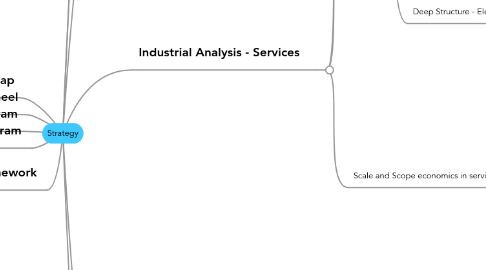
1. Mind Map
2. Impact Wheel
3. Why Diagram
4. Influence Diagram
5. Describing Strategy Framework
5.1. Clear set of long term goals
5.2. scope of business
5.3. competitive advantage
5.4. strategic logic
6. ...the determination of the basic long term goals and objectives of an enterprise, and the adoption of courses of action and the allocation of resources necessary for carrying out these goals…
7. ...a unified, comprehensive, and integrated plan designed to ensure that the basic objectives of the enterprise are achieved…
8. Macro and Micro Environment Analysis
8.1. The PESTLE framework is designed to identify macro-level influences on a firm or industry,
8.1.1. relative strengths of these drivers
8.1.2. anticipate the changes in these drivers over time
8.1.3. (political, economic, social, technological, legal, environmental)
8.1.4. 1. List external PESTLE factors for the organisation.
8.1.5. 2. Identify the implications of each PESTLE factor for the organisation.
8.1.6. 3. Decide the importance of the implications of the external factors – rank or rate them. Normally this involves assessing their impact over time, impact by type (positive or negative affects) and impact by dynamics (that is, is the significance/importance of the implication increasing, decreasing or remaining unchanged).
8.1.7. 4. Rate the importance of the implication to the organisation. This may be further refined by ranking the likelihood of it happening.
8.1.8. 5. Scenario building: to develop scenarios of different alternative futures for the organisation.
8.1.9. can identify changes that may affect the relative strengths of the forces acting on an industry, and may complement or inform a Five Forces analysis.
8.2. SWOT focuses on the external and internal environment of the particular organisation.
8.2.1. SW
8.2.1.1. Management and Organisation
8.2.1.2. Operations
8.2.1.3. Finance
8.2.1.4. Other factors important to Organisation
8.2.2. OT
8.2.2.1. Governmental Change
8.2.2.2. Economic Changes
8.2.2.3. Market Change
8.2.2.4. Competitive Change
8.2.2.5. Societal Changes
8.2.2.6. Supplier Change
8.3. Deep Structure - Elements would be exchange rates, government regulations, tariffs, interest rates, social changes, and tax rates. The
9. Industrial Analysis - Services
9.1. Characteristics
9.1.1. Intangibility
9.1.1.1. branding, establilshing customer trust
9.1.2. Heterogeneous
9.1.2.1. control of offering at transaction point
9.1.3. Simultaneous production and consumprion
9.1.3.1. buy a service brand
9.1.4. Perishable
9.1.4.1. reusable, tradeable, optimal capacity utilisation
9.2. Value Chain
9.2.1. Product design
9.2.2. marketing
9.2.3. distribution
9.2.4. service provision
9.2.5. service monitoring and enhancement
9.2.5.1. feedback to product design
9.3. Scale and Scope economics in services
9.3.1. Scale
9.3.1.1. Geographic network
9.3.1.2. physical building or equipment
9.3.1.3. pucrahsing / supply
9.3.1.4. marketing
9.3.1.5. logistics and ditribution
9.3.1.6. technology / ICT
9.3.1.7. operationsl support
9.3.2. scope
9.3.2.1. ICT and shared information networks
9.3.2.2. shared knowledge and know-how effects
9.3.2.3. product or process innovation
9.3.2.4. shared R&D
9.3.2.5. Shared channels for multiple offerings
9.3.2.6. Shared investment and costs
9.3.2.7. Reproduction formula for service system
9.3.2.8. Range of services and service development
9.3.2.9. Brancding
9.3.2.10. Training
9.3.2.11. Goodwill and corporate identity
9.3.2.12. Culture
9.3.2.13. Privileged access to paretn services
10. Resources
10.1. Resources for sustained competitive advanage
10.1.1. valuable
10.1.2. rare
10.1.3. imperfectly imitable
10.1.4. non-substitutable
10.2. Resources
10.2.1. Brand name
10.2.2. inhouse knowledge of technology
10.2.3. employment of skilled personnel
10.2.4. trade contracts
10.2.5. machinery
10.2.6. efficient procedures
10.2.7. captital
10.3. core competence
10.3.1. provide access to wide variety of markets
10.3.2. significant contribution to customers' perceived benefit from final product
10.3.3. difficult to imitate
10.4. Capability to deploy resources
10.5. Dynamic Capabilities - match and even create market change
10.6. Knowledge leading to competitive advatnage
10.6.1. tacit , knowledge can be codified
10.6.2. context specificity , knowledge is dependent on local environment
10.6.3. dispersion - knowledge spread around the organisation or confiedm to few people
